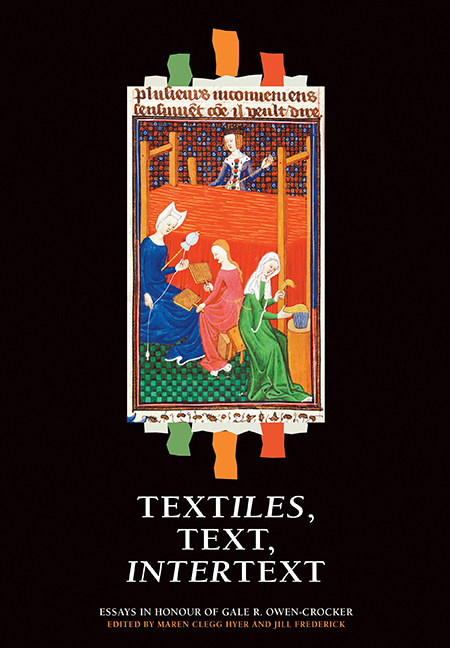Book contents
- Frontmatter
- Contents
- List of Illustrations
- List of Abbreviations
- Introduction
- A Personal Recollection
- List of publications of Gale R. Owen Crocker
- Part I Textile
- Part II Text
- Part III Intertext
- 10 Weaving Words on the Ruthwell Cross
- 11 Fates of the Apostles and Tituli
- 12 Weaving and Interweaving: The Textual Traditions of Two of Ælfric's Supplementary Homilies
- 13 Invisible Things in London, British Library, Cotton Vitellius A. xv
- 14 Redacting Harold Godwinson: The Vita Haroldi and William of Malmesbury
- Index
- Tabula Gratulatoria
11 - Fates of the Apostles and Tituli
from Part III - Intertext
Published online by Cambridge University Press: 05 July 2016
- Frontmatter
- Contents
- List of Illustrations
- List of Abbreviations
- Introduction
- A Personal Recollection
- List of publications of Gale R. Owen Crocker
- Part I Textile
- Part II Text
- Part III Intertext
- 10 Weaving Words on the Ruthwell Cross
- 11 Fates of the Apostles and Tituli
- 12 Weaving and Interweaving: The Textual Traditions of Two of Ælfric's Supplementary Homilies
- 13 Invisible Things in London, British Library, Cotton Vitellius A. xv
- 14 Redacting Harold Godwinson: The Vita Haroldi and William of Malmesbury
- Index
- Tabula Gratulatoria
Summary
It took some three generations before scholars were able to find it easy to cross the disciplinary lines between art history and literature to draw out the power and beauty of the Dream of the Rood. Fortunately, scholarship has moved on from the divisions of the past, thanks to the intellectual leadership of Gale R. Owen-Crocker and others who can bridge the gap between merely literary possibilities and material evidence, redefining what a “text” might be and how intertextuality is a more fruitful way to approach the various texts that have come down to us. Controversies still remain, notably concerning which came first: the incised stone cross and its text or the poem inscribed in the Vercelli Book, yet there is no doubt that there are two forms of the text that are extant, whatever the chronological or genetic relationship might be and whatever any special issues from stone constructions, say, might intrude. The Dream of the Rood has emerged as the masterpiece of the Vercelli Book, as the now standard Guide to Scholarship demonstrates, and the intertextual achievement of its era. But Dream hints at a possibly more subtle place in Old English literary history, pointing to a way of composing Old English poetry elsewhere in the canon. The suggestion here is that The Fates of the Apostles may provide another example of a text of art that is incorporated into a literary text. How Fates might echo Dream and how its structure works relative to Dream will be themes in this chapter, though the suggestion of the mutual connection of art and literature is the overriding intention of this argument. The literary analysis of Fates is the appropriate beginning from which to trace the connection between poem and artifact and to focus on the central core of Fates.
Rightly dismissing earlier literary criticism of Fates as grossly unsympathetic, James L. Boren proposes an approach to the poem through an examination of its formal elements “to offer a new critical perspective”. Boren's project is classic “new criticism” in its intention and method, as he concentrates on showing a basic pattern of elements in the key section that relates how each apostle preached and died.
- Type
- Chapter
- Information
- Textiles, Text, IntertextEssays in Honour of Gale R. Owen-Crocker, pp. 199 - 210Publisher: Boydell & BrewerPrint publication year: 2016



